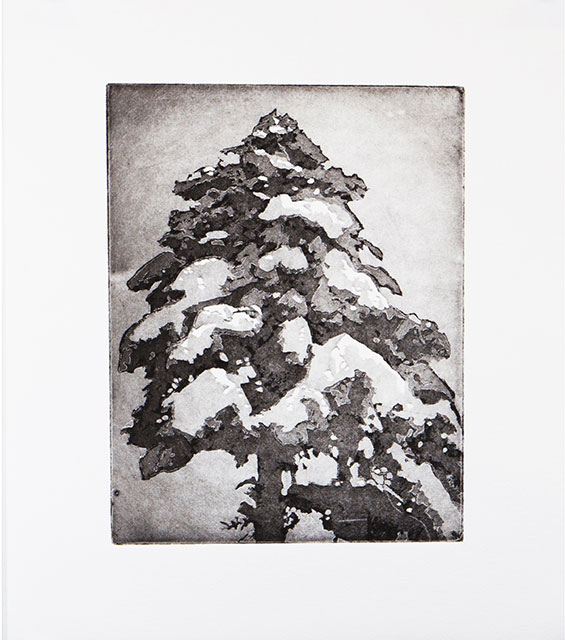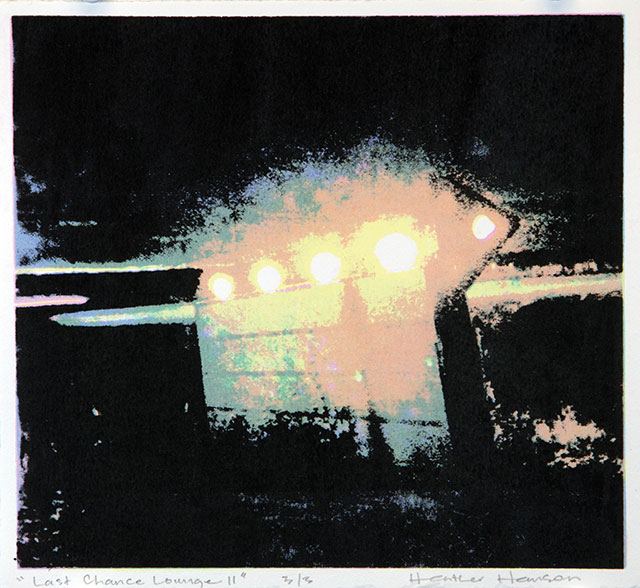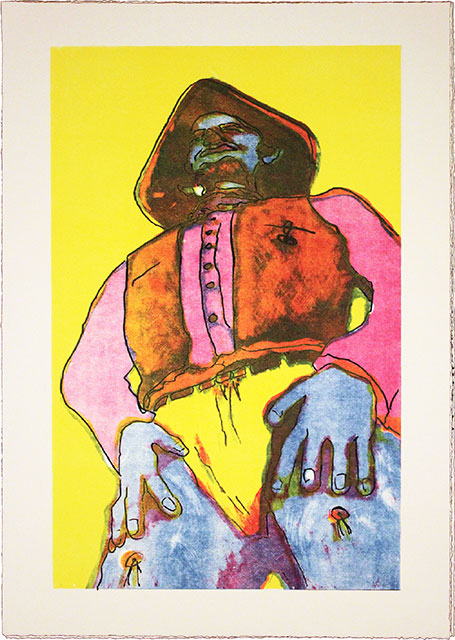Heather Hanson
 Hanson is an artist of the American West working out of Golden, Colorado. Hanson’s work contemplates American iconography, our disappearing surroundings, coincidence, happenstance, and the road. Works incorporate landscape and a mysticism in the mundane. Most often a print, she combines various printmaking techniques with bright process colors.
Hanson is an artist of the American West working out of Golden, Colorado. Hanson’s work contemplates American iconography, our disappearing surroundings, coincidence, happenstance, and the road. Works incorporate landscape and a mysticism in the mundane. Most often a print, she combines various printmaking techniques with bright process colors.
Hanson’s work has been exhibited in Colorado, Wyoming, Kansas, New Mexico, Utah, Texas, Washington, New York, and Colombia. She is in collections at the University of Colorado Boulder, the University of Wyoming and Texas Tech University.

Douglas (2018), Heather Hanson, Copperplate Aquatint Etching Ink on BFK Rives 280 GSM Printmaking Paper. Edition 1/5 (1AP)
“The fir depicted in Douglas stands over 100 feet tall and has rooted itself in the center of the thoroughfare. We are friends, but I know at some point, either he or I must go.
The Douglas fir was named after Scottish botanist David Douglas who sent the seeds back to the British Isles in 1827. First noted in 1791 by Dr. Archibald Menzies on Vancouver Island, the Douglas fir is second only to the giant sequoia in stature. The Douglas can grow up to 325 feet tall with a girth up to 17. It is a strong wood and the largest timber producer in the United States.
The aquatint forms in Douglas recall the early modernists from the first half of the twentieth century, Charles Burchfield and Oscar Bluemner. Bulbous and animated. Spirited and alive.” Heather Hanson

Last Chance Lounge II (2018), Heather Hanson, 4 color serigraph, No.1 of 3. Individually pulled, Acrylic and Water based ink and BFK Rives 280 gsm printmaking paper (10 inches by 10 inches).
“In Last Chance Lounge II, the darkness of the rural road is illuminated with the promise of a last refuge before the loneliness of the nighttime ride ahead, by the animated lights that form an arrow. We can anticipate the pulse of the next bulb that points the way into the overgrown, dusty lot.” Heather Hanson

Rawlins (2018), Heather Hanson, 1 color aquatint etching, No.3 of 5. Individually pulled, Hanco intaglio ink and BFK Rives 280 gsm printmaking paper (10.5 inches by 11 inches).
“Twentysix Gas Stations is considered the first artist’s book. Created in 1963 by Edward Ruscha, the book contained no text and would be rejected by the Library of congress citing its “unorthodox form and supposed lack of information”. Ruscha’s intent with this series was to approach his subjects without emotion or explanation. Precluded by Edward Hopper’s, Gas from 1940, it does not possess the objective to put forth any narrative or emotion, rather, it is an “intimate transcription’ of the American landscape. Inspired by Ruscha and Hopper, the station represented in Rawlins, embodies the spirit of this blustery Wyoming boulevard. Just off the 80 interstate, the station is a whisper of a more industrial, petroleum-fueled era, having just past.” Heather Hanson

Tall Tales I (2019), Heather Hanson, 4 color Monotype / Serigraph No.3 of 3 VE (3/AP).
Individually pulled, Akua lithographic ink and BFK Rives 280 gsm printmaking paper (18 inches by 28 inches).
“Tall Tales I is part of a series of gigantic icons found towering over the contemporary landscape. In the West, where the biggest is celebrated, and we are witness to the grandiose, the manufactured idolization of the western cowboy is prolific. The modern legend of the cowboy, fostered by Filmmaker John Ford, Wild West Shows, and dime store novels, does precious little to reflect the true brutality of the Western Frontier. Tall Tales explores the condition of “that which is often not what it seems”.
The Western Cowboy is a western deity embodied by this monumental concrete cowboy.
Intended for a theme park in the 1950s, the “concrete cowboy” creator John Sutton specialized in large cement displays for zoos and parks in Denver and the Bronx. Its actual placement is located at the entrance of the Rustic Ranch Trailer Court along Hwy 287 on Denver’s Federal Blvd. Directionally challenged, it is the first landmark I oriented myself with upon arriving to the city. The gigantic sculpture dwarfs the caravans that surround it in a joyful dichotomy. The enormous 30 foot icon intimates memory of fanciful kitsch that signals the traveler to stop. Mythology and mysticism for those who settle.” Heather Hanson
